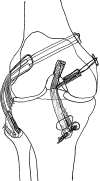Double-bundle PCL and posterolateral corner reconstruction components are codominant
- PMID: 18523834
- PMCID: PMC2493001
- DOI: 10.1007/s11999-008-0319-z
Double-bundle PCL and posterolateral corner reconstruction components are codominant
Abstract
A more complete biomechanical understanding of a combined posterior cruciate ligament and posterolateral corner knee reconstruction may help surgeons develop uniformly accepted clinical surgical techniques that restore normal anatomy and protect the knee from premature arthritic changes. We identified the in situ force patterns of the individual components of a combined double-bundle posterior cruciate ligament and posterolateral corner knee reconstruction. We tested 10 human cadaveric knees using a robotic testing system by sequentially cutting and reconstructing the posterior cruciate ligament and posterolateral corner. The knees were subjected to a 134-N posterior tibial load and 5-Nm external tibial torque. The posterior cruciate ligament was reconstructed with a double-bundle technique. The posterolateral corner reconstruction included reattaching the popliteus tendon to its femoral origin and reconstructing the popliteofibular ligament. The in situ forces in the anterolateral bundle were greater in the posterolateral corner-deficient state than in the posterolateral corner-reconstructed state at 30 degrees under the posterior tibial load and at 90 degrees under the external tibial torque. We observed no differences in the in situ forces between the anterolateral and posteromedial bundles under any loading condition. The popliteus tendon and popliteofibular ligament had similar in situ forces at all flexion angles. The data suggest the two bundles protect each other by functioning in a load-sharing, codominant fashion, with no component dominating at any flexion angle. We believe the findings support reconstructing both posterior cruciate ligament bundles and both posterolateral corner components.
Figures






References
-
- {'text': '', 'ref_index': 1, 'ids': [{'type': 'PubMed', 'value': '12642256', 'is_inner': True, 'url': 'https://pubmed.ncbi.nlm.nih.gov/12642256/'}]}
- Ahmad CS, Cohen ZA, Levine WN, Gardner TR, Ateshian GA, Mow VC. Codominance of the individual posterior cruciate ligament bundles: an analysis of bundle lengths and orientation. Am J Sports Med. 2003;31:221–225. - PubMed
-
- {'text': '', 'ref_index': 1, 'ids': [{'type': 'DOI', 'value': '10.1177/036354658301100505', 'is_inner': False, 'url': 'https://doi.org/10.1177/036354658301100505'}, {'type': 'PubMed', 'value': '6638245', 'is_inner': True, 'url': 'https://pubmed.ncbi.nlm.nih.gov/6638245/'}]}
- Bianchi M. Acute tears of the posterior cruciate ligament: clinical study and results of operative treatment in 27 cases. Am J Sports Med. 1983;11:308–314. - PubMed
-
- {'text': '', 'ref_index': 1, 'ids': [{'type': 'DOI', 'value': '10.1177/036354659602400310', 'is_inner': False, 'url': 'https://doi.org/10.1177/036354659602400310'}, {'type': 'PubMed', 'value': '8734880', 'is_inner': True, 'url': 'https://pubmed.ncbi.nlm.nih.gov/8734880/'}]}
- Boynton MD, Tietjens BR. Long-term followup of the untreated isolated posterior cruciate ligament-deficient knee. Am J Sports Med. 1996;24:306–310. - PubMed
-
- {'text': '', 'ref_index': 1, 'ids': [{'type': 'DOI', 'value': '10.1177/036354658401200409', 'is_inner': False, 'url': 'https://doi.org/10.1177/036354658401200409'}, {'type': 'PubMed', 'value': '6476188', 'is_inner': True, 'url': 'https://pubmed.ncbi.nlm.nih.gov/6476188/'}]}
- Cross MJ, Powell JF. Long-term followup of posterior cruciate ligament rupture: a study of 116 cases. Am J Sports Med. 1984;12:292–297. - PubMed
-
- {'text': '', 'ref_index': 1, 'ids': [{'type': 'PubMed', 'value': '7068728', 'is_inner': True, 'url': 'https://pubmed.ncbi.nlm.nih.gov/7068728/'}]}
- Dandy DJ, Pusey RJ. The long-term results of unrepaired tears of the posterior cruciate ligament. J Bone Joint Surg Br. 1982;64:92–94. - PubMed
Publication types
MeSH terms
LinkOut - more resources
Full Text Sources
Medical

